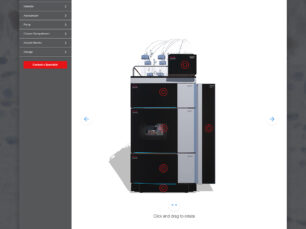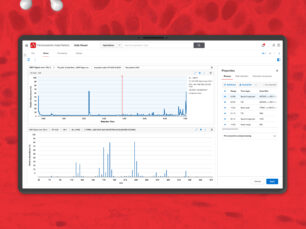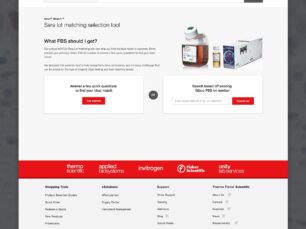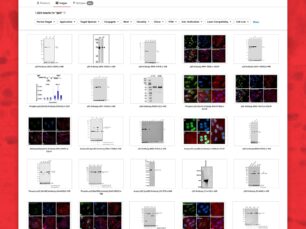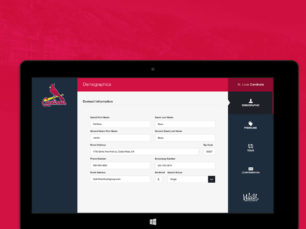
Thermo Fisher Scientific
Antibodies Epitope Search
Overview
Thermo Fisher Scientific is the world leader in serving science. Their mission is to enable customers to make the world healthier, cleaner and safer. They offer thousands of primary and secondary antibodies validated and cited for flow cytometry, IHC/IF/ICC, western blotting, ELISA, and other applications. As the lead UX designer for antibodies, I had the privilege of contributing to the search experience. Our goal was to develop a user-friendly experience that simplifies the search for antibody products through the visual evaluation of sequence range data.
Challenge
One of the pivotal challenges we faced was ensuring seamless coordination between the sequence range slider and the corresponding results displayed underneath. It was imperative that as users adjusted the slider, the results would dynamically populate and update in real time. This required meticulous synchronization between the interactive slider component and the underlying data, enhancing the user’s ability to navigate and explore the sequence information effortlessly. Additionally, we needed to design various sequence range variations, including Single Point (Close to N Terminal), Single Range (Close), N-Terminal, and C-Terminal. These variations were essential to cater to the diverse needs of researchers and scientists, allowing them to refine their search parameters with precision and efficiency.
Sequence Range Variations
In response to the diverse needs of researchers and scientists, we developed a comprehensive system that catered to various sequence range variations. Understanding the importance of precision in identifying the sequence range, we implemented distinct options to accommodate different search criteria:
Single Point (Close to N Terminal)
This option allows users to specify a single amino acid position, enabling them to focus on a specific location within the sequence, particularly close to the N Terminal.
Single Range (Close)
Users can define a single range of amino acid positions, facilitating the examination of a contiguous segment of the sequence, especially in proximity to a specific point of interest.
N-Terminal
Catering to researchers interested in analyzing the beginning of the protein sequence, this option highlights the amino acids located at the N-Terminal end, providing insights into the initial structure and characteristics of the protein.
C-Terminal
Similarly, for users interested in exploring the end of the protein sequence, this option focuses on the amino acids situated at the C-Terminal end, offering valuable information regarding the protein’s termination and potential functional domains.
By offering these distinct sequence range variations, we empowered researchers and scientists to effectively identify and analyze the sequence regions relevant to their research goals. This flexibility not only enhanced the usability of the platform but also facilitated accurate and efficient antibody product selection based on specific sequence attributes.

Solution
To address the challenge of synchronizing the sequence range slider with the displayed results, we implemented a robust solution that ensured seamless interaction and real-time updates. Leveraging advanced frontend development techniques, we designed the slider component to dynamically communicate with the backend database. As users adjusted the slider to specify their desired sequence range, the corresponding results underneath would instantaneously populate and update, providing a fluid and responsive user experience.
Moreover, in response to the need for various sequence range variations, we developed a flexible system that allowed users to choose from different options such as Single Point (Close to N Terminal), Single Range (Close), N-Terminal, and C-Terminal. This customization capability empowered researchers and scientists to tailor their search criteria precisely to their specific requirements, enhancing the efficiency and accuracy of their antibody product exploration.







Patent
Our patented technology encompasses a sequence range web component that revolutionizes the process of finding appropriate antibody products. By harnessing the power of visual evaluation of sequence information, we have created an intuitive platform that empowers researchers and scientists worldwide.
Key features of our patented experience include:
Responsive Antibody Product Listing
Our user interface generates a dynamic antibody product listing that adapts in real-time to user interactions. Each listed product includes comprehensive sequence information and detailed product specifications, facilitating informed decision-making.
Sequence Range Component
We have developed a unique sequence range component based on corresponding sequence information. This component incorporates an amino acid sequence area of interest indicator, providing users with enhanced visibility and clarity. Furthermore, the sequence range component is aligned relative to an array of sequence range data, optimizing readability and comparison.
This patent not only recognizes our team’s dedication to innovation but also solidifies our position as pioneers in the field of antibody research. By securing intellectual property rights for our inventive solution, we affirm our commitment to advancing scientific discovery and empowering researchers worldwide.
Conclusion
In conclusion, the Antibodies Epitope Search project exemplifies our commitment to user-centered design and innovation. By addressing the complex challenges associated with antibody research, we have delivered a solution that empowers researchers and scientists to accelerate their discoveries. Moving forward, we remain dedicated to refining and enhancing the platform to meet the evolving needs of the scientific community.


